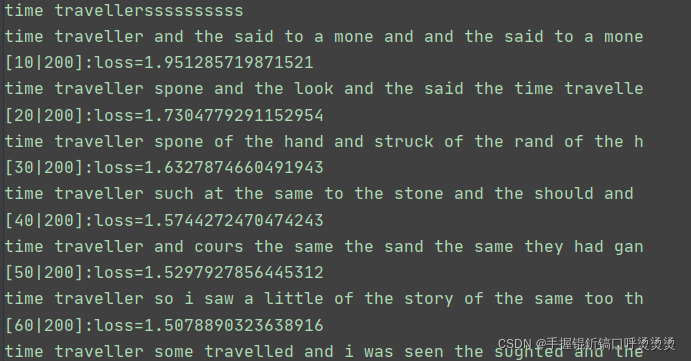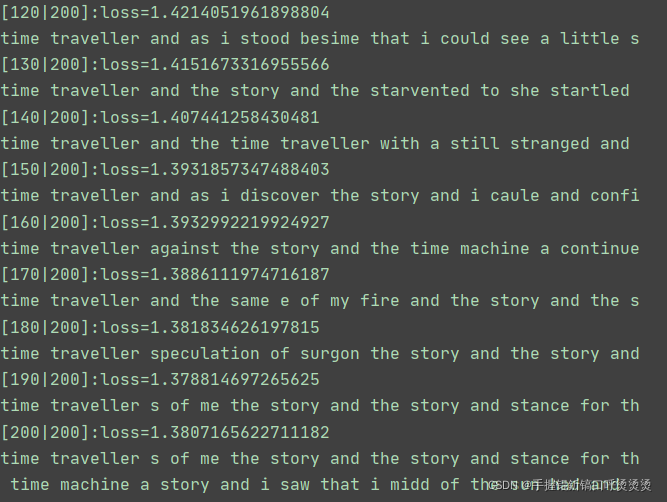这里省略了文本数据和数据集构建。具体可以查看这里。(这个是之前我按照李沐老师的课写的)
RNN输入输出
输入为当前向量
x
x
x(词),输出为预测向量
y
y
y。隐藏状态设为
h
h
h。其和上一个输入和上一个隐藏状态相关。RNN具体输入输出公式为:
h
t
=
?
(
x
t
W
x
h
+
h
t
?
1
W
h
h
+
b
h
)
y
t
=
?
(
h
t
W
h
y
+
b
y
)
h_t = \phi( x_tW_{xh}+h_{t-1}W_{hh}+b_h)\\ y_t = \phi(h_tW_{hy}+b_y)
ht?=?(xt?Wxh?+ht?1?Whh?+bh?)yt?=?(ht?Why?+by?)
在第一个
x
x
x输入时隐藏状态这里设为torch.zero((1, batch_size, num_hidden))
定义参数
import math
import torch
from torch import nn
from torch.nn import functional as F
# load_text函数参考链接
batch_size, num_steps = 32, 35
train_iter, vocab = load_text(tokens, batch_size, num_steps)
print(vocab.idx_to_token)
# 隐藏层大小
num_hidden = 256
rnn_layer = nn.RNN(len(vocab), num_hidden)
# 定义隐状态 (隐层数,批量大小, 隐藏单元数)
state = torch.zeros((1, batch_size, num_hidden))
定义RNN网络
class RNNmodel(nn.Module):
def __init__(self, rnn_layer, vocab_size, **kwargs):
super(RNNmodel, self).__init__(**kwargs)
self.rnn = rnn_layer
self.vocab_size = vocab_size
self.num_hiddens = self.rnn.hidden_size
if not self.rnn.bidirectional:
self.num_directions = 1
self.liner = nn.Linear(self.num_hiddens, self.vocab_size)
else:
self.num_directions = 2
self.liner = nn.Linear(self.num_hiddens * 2, self.vocab_size)
def forward(self, inputs, state):
X = F.one_hot(inputs.T.long(), self.vocab_size)
X = X.to(torch.float32)
Y, state = self.rnn(X, state)
output = self.liner(Y.reshape((-1, Y.shape[-1])))
return output, state
def begin_state(self, device, batch_size=1):
if not isinstance(self.rnn, nn.LSTM):
# `nn.GRU` 以张量作为隐藏状态
return torch.zeros((self.num_directions * self.rnn.num_layers,
batch_size, self.num_hiddens),
device=device)
else:
return (torch.zeros((
self.num_directions * self.rnn.num_layers,
batch_size, self.num_hiddens), device=device),
torch.zeros((
self.num_directions * self.rnn.num_layers,
batch_size, self.num_hiddens), device=device))
定义预测函数
def predict(prefix, num_preds, net, vocab, device):
state = net.begin_state(batch_size=1, device=device)
outputs = [vocab[prefix[0]]]
get_input = lambda: torch.tensor([outputs[-1]], device=device).reshape((1, 1))
for y in prefix[1:]:
_, state = net(get_input(), state)
outputs.append(vocab[y])
for _ in range(num_preds):
y, state = net(get_input(), state)
outputs.append(int(y.argmax(dim=1).reshape(1)))
return ''.join(vocab.to_tokens(outputs))
device = 'cuda:0' if torch.cuda.is_available() else 'cpu'
net = RNNmodel(rnn_layer, len(vocab))
net = net.to(device)
predict('time traveller', 10, net, vocab, device)
输出:
'time travellerbbfbxbbbbf'
定义训练函数
def train_epoch(net, train_iter, loss, updater, device, use_random_iter):
state = None
L = torch.tensor([])
for X, Y in train_iter:
if state is None or use_random_iter:
state = net.begin_state(batch_size=X.shape[0], device=device)
else:
if isinstance(net, nn.Module) and not isinstance(state, tuple):
# `state` is a tensor for `nn.GRU`
state.detach_()
else:
# `state` is a tuple of tensors for `nn.LSTM` and
# for our custom scratch implementation
for s in state:
s.detach_()
y = Y.T.reshape(-1)
X, y = X.to(device), y.to(device)
y_hat, state = net(X, state)
l = loss(y_hat, y.long()).mean()
L = torch.cat((L, torch.tensor([l])), 0)
updater.zero_grad()
l.backward()
if isinstance(net, nn.Module):
params = [p for p in net.parameters() if p.requires_grad]
else:
params = net.params
norm = torch.sqrt(sum(torch.sum((p.grad ** 2)) for p in params))
if norm > 1: # 这里1可以自定义
for param in params:
param.grad[:] *= 1 / norm
updater.step()
return torch.mean(L)
def train(net, train_iter, vocab, lr, num_epochs, device, use_radom=False):
loss = nn.CrossEntropyLoss()
if isinstance(net, nn.Module):
updater = torch.optim.SGD(net.parameters(), lr)
else:
return 'wrong'
pre = lambda prefix: predict(prefix, 50, net, vocab, device)
# 训练
for epoch in range(num_epochs):
l = train_epoch(net, train_iter, loss, updater, device, use_radom)
if (epoch + 1) % 10 == 0:
print(pre('time traveller'))
print("[{}|{}]:loss={}".format(epoch+1, num_epochs, l))
print(pre('time traveller'), '\n', pre('time machine'))
num_epochs, lr = 200, 2
train(net, train_iter, vocab, lr, num_epochs, device)
截取部分输出

